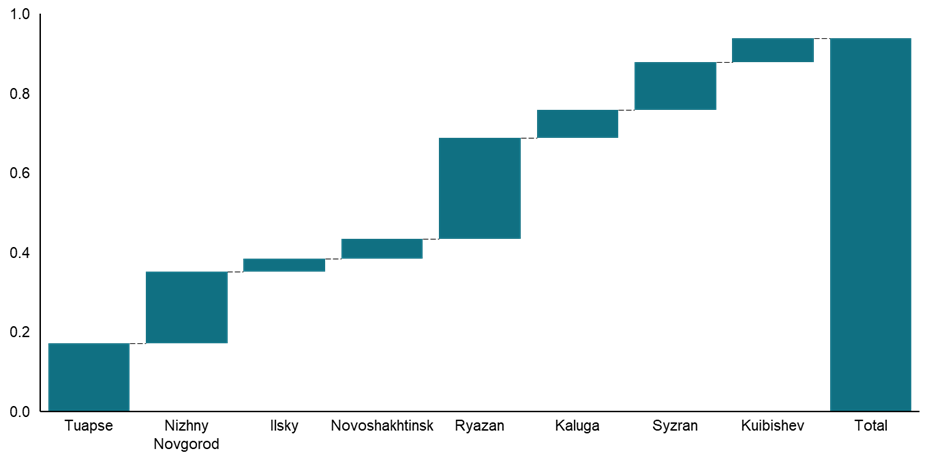
Russia has historically been a major player in the global oil market, not only as a leading crude oil exporter but also as a significant supplier of refined oil products. For years, it has been a key source of diesel, fuel oil, and other refined oil products for Europe, Asia-Pacific (APAC) including China, and CIS countries. However, the dynamics of the refining market have shifted considerably since the start of the Russia-Ukraine war in late February 2022.
In 2023, ADI Analytics published a blog about the impact of the war and Western sanctions on the Russian fossil fuel market. For instance, the G7 price cap on Russian oil and refined oil products, along with restrictions on shipping and insurance services, has led to discounted prices and a massive shift toward export markets in South America and Asia, such as Brazil, Turkey, China, and India. Although Russia has managed to find new buyers for its refined oil products, economic sanctions continue to hurt Russian refiners. Russia’s export revenue for refined oil products has slumped by 13% annually, reaching an average of ~$220 million per day in 2024—a noticeable drop since 2022 levels (see Exhibit 1).

Exhibit 1: Russia’s refined oil products export revenue (USD million per day). Source: Centre for Research on Energy and Clean Air, ADI.
As of the time this blog is being posted, the U.S. and Russia are engaged in ceasefire negotiations, though no agreement has been reached. Should the peace talks come to fruition, several key implications for the global refining market could emerge:
- Increased pressure on global refining margins
Around 1 million barrels per day of Russia’s refining capacity (see Exhibit 2) has gone out of service in 2024 due to the conflict, primarily caused by drone attacks. If peace is achieved, this refining capacity could gradually come back online, leading to a significant increase in the supply of refined oil products such as diesel, naphtha, and fuel oil in Russia. The influx of Russian refined oil products supply could intensify competition in key export markets at a time when oil demand growth is sluggish globally, further squeezing global refining margins.

Exhibit 2: Russian refining capacity outages in 2024 (Million barrels per day).
- Potential return to the EU market in the near term
A peace agreement could lead to the relaxation or lifting of international sanctions on Russia. European countries might reconsider their energy strategies and potentially increase imports of Russian refined oil products, which could lead to a drop in fuel prices. However, the EU’s efforts to transition away from fossil fuels continue to gain momentum and refined oil product imports are likely to decline in the future. For example, the FuelEU Maritime regulations that came into force in Jan 2025, aim to reduce diesel consumption in the region. As a result, Russia may need to continue relying on alternative markets such as the Middle East, Africa, and APAC in the long term as the EU undergoes energy transition.
- Russia continues to export naphtha, focusing on the APAC market
Following the 2023 import bans by Western countries, Russia has significantly expanded its presence in the APAC market. Taiwan, for example, is reported to account for up to 78% of Novatek’s monthly naphtha exports. Additionally, China and India together now represent over 50% of APAC imports of Russian refined oil products since the EU sanctions (see Exhibit 3). Both countries are also expected to continue expanding their refining capacities this decade and are likely to integrate their refining capacities with petrochemical production, boosting naphtha processing capabilities and enhancing flexibility to switch between fuels and petrochemicals.

Exhibit 3: Import of Russian refined oil products in APAC since EU sanctions until January 2025 (USD billion). Source: Centre for Research on Energy and Clean Air, ADI.
Conclusion
While a comprehensive peace agreement may remain elusive, a mutual ceasefire between Russia and Ukraine could see Russian refining capacity gradually come back online, further pressuring global refining margins. The lifting of sanctions could shift trade flows, allowing Russian crude oil and refined products potential re-entry into European markets. Additionally, Russia is likely to maintain a strong presence in the APAC market, driven by sustained demand from China, India, and Taiwan. Despite these possibilities, the outlook for Russia’s refining industry remains uncertain and volatile until a peace agreement is reached. At ADI Analytics, we continue to monitor developments in the energy sector and analyze their impact on market dynamics to help our clients make informed decisions.
– Edmund Lam
Please contact ADI at info@adi-analytics.com if you would like to gain an in-depth understanding of global market trends and dynamics in the refining industry, its future prospects, and how it may affect global trade movements.
ADI Analytics is a prestigious, boutique consulting firm specializing in oil & gas, energy transition, and chemicals since 2009. We bring deep, first-rate expertise in a broad range of markets including refining markets, where we support Fortune 500, mid-sized and early-stage companies, and investors with consulting services, research reports, and data and analytics, with the goal of delivering actionable outcomes to help our clients achieve tangible results.
We also host the ADI Forum, one of Houston’s distinguished industry conferences, to bring c-suite executives from oil & gas, energy transition, and chemicals together for meaningful dialogue and strategic insights across the value chains.
Subscribe to our newsletter or contact us to learn more.



















